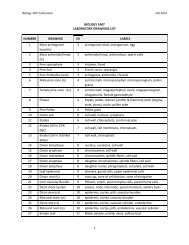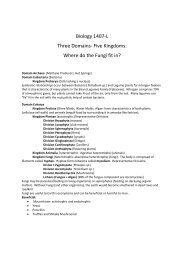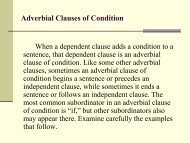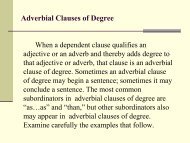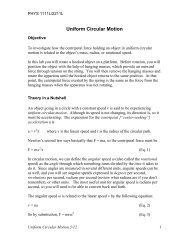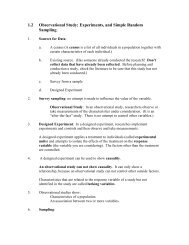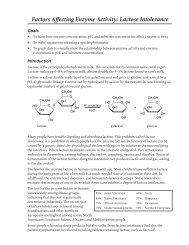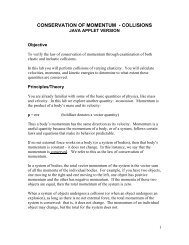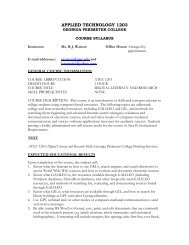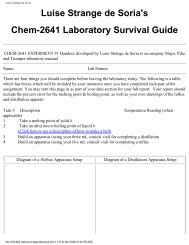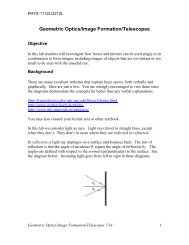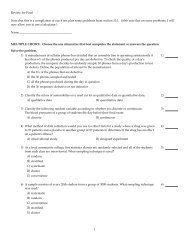Biology 1403 Lab Syllabus - Faculty & Staff, Georgia Perimeter ...
Biology 1403 Lab Syllabus - Faculty & Staff, Georgia Perimeter ...
Biology 1403 Lab Syllabus - Faculty & Staff, Georgia Perimeter ...
Create successful ePaper yourself
Turn your PDF publications into a flip-book with our unique Google optimized e-Paper software.
<strong>Biology</strong> <strong>1403</strong>L - Diversity of the Living World <strong>Lab</strong>oratory <strong>Syllabus</strong><br />
<strong>Georgia</strong> <strong>Perimeter</strong> College - Dunwoody Campus<br />
Term: Summer Section #: 245<br />
Instructor<br />
Name: Houng Park Phone: 770-714-7454<br />
Office: Office Hours: 2:30PM- 4:30PM Tuesday and Thursday<br />
___________________________________________________________________________________<br />
E-mail / web page: hpark@gpc.edu<br />
Class meeting location: Room NE-1300; Class meeting day and time: 11:30AM to 2:30PM T and TR<br />
Prerequisite: Exit or exemption from Developmental Studies English, Reading, and ESL.<br />
Corequisite: BIOL <strong>1403</strong> Lecture. You must be registered for both lab and lecture at the same time. Withdrawal from<br />
either lecture or lab will result in automatic withdrawal from both. It is strongly suggested that you take lecture and lab on<br />
the same campus and on the same schedule (half term or full term). <strong>Lab</strong> topics on this campus follow the order of<br />
lecture topics on this campus. If you take lecture on a different campus, topics may be covered in a different order.<br />
Course description: This course provides the student with hands-on experience with a variety of living and preserved<br />
organisms, including animals, plants, fungi, protozoa, algae, and bacteria, and the principles of evolution and ecology that<br />
unite them. This course is designed for non-science majors.<br />
Course objectives: As a consequence of completing this course, the student will be able to:<br />
1. To allow students to develop laboratory skills and techniques; to read and follow directions; and to perform<br />
experiments requiring analysis and interpretation of data, as well as written discussion of the results.<br />
2. Identify and describe the distinguishing features of each of the kingdoms, and the major groups within each kingdom.<br />
3. Identify particular specimens as members of the kingdoms and their subgroups.<br />
4. State the major premises of the theory of evolution by natural selection, and identify and explain examples of evidence<br />
for the theory.<br />
5. Relate the characteristics of living organisms and preserved specimens to life processes.<br />
6. Collect, analyze, and use data to describe the interactions among organisms and their environments.<br />
Required text: Mader, Sylvia S. 2007. <strong>Biology</strong> <strong>1403</strong> – Selected <strong>Lab</strong>s from <strong>Biology</strong> <strong>Lab</strong>oratory Manual - 9th ed.<br />
Grade determination: The final letter grade will be determined in the following manner:<br />
Test I 100 pts Total points Percent Grade<br />
Test II 100 pts 270 - 300 90 - 100 % A<br />
2 <strong>Lab</strong> reports 60 pts (30pts. ea.) 240 - 269 80 - 89 % B<br />
Drawings 15 pts 210 - 239 70 - 79 % C<br />
Instructor option 25 pts 180 - 209 60 - 69 % D<br />
Total 300 pts < 180
Drawings of materials observed during lab are an important part of the course. These drawings are intended to<br />
help the student see more detail of these materials and should enhance understanding of the organisms and their<br />
characters. A notebook of drawings must be kept and turned in as requested. A description of the proper format for<br />
drawings and a list of drawings are included in this syllabus.<br />
The portion of the grade designated as "Instructor Option" is at the discretion of individual instructor and may<br />
consist of quizzes, pre-lab assignments, an additional lab report, or other assignments. The exact nature of the instructor<br />
option will be discussed by each instructor on the first day of lab.<br />
My instructor has chosen the following option: _______________________________________________<br />
In addition to this syllabus, a lab schedule will also be distributed on the first day of lab. This schedule will<br />
outline the specific dates for each lab exercise, as well as major tests. While every effort will be made to adhere to the lab<br />
schedule, deviations may be necessary due to inclement weather or unforeseen emergencies. Your instructor may also<br />
distribute an addendum that will outline their specific policy on lab reports, drawings, and the instructor option.<br />
Attendance policy<br />
1. Students who miss lab exercises perform very poorly in this course. The primary objective of any lab course is to<br />
provide the student with a “hands-on” experience that will support and illustrate the concepts covered in the lecture<br />
portion of the course. <strong>Lab</strong> is about seeing and doing. Therefore, consistent and timely attendance to lab is a must for<br />
success in this course!<br />
2. There will be no make-up lab exercises. Due to logistical and safety concerns, “wet labs” (labs requiring the use of<br />
equipment, chemicals, solutions, etc) cannot be made up. Any grades collected during the missed class, such as quizzes,<br />
cannot be made up and will be recorded as a zero. If a student misses a laboratory exercise, the exercise cannot be used<br />
for a laboratory report. Students are responsible for any information covered in their absence. Open lab time is available<br />
on most Fridays (8:00am-12:00pm) for review of slides, models, and some living specimens only.<br />
3. <strong>Lab</strong> will start promptly at the scheduled time. Important introductory and safety information will be given at the<br />
beginning of each lab. Late arrival to lab will affect your understanding of the entire lab exercise and may pose a safety<br />
hazard to you and other students. If a quiz is given at the beginning of the lab, a student arriving late will not be<br />
allowed to take the quiz.<br />
4. The "practical" format of lab exams makes "make-up exams" difficult to arrange and administer; each student should<br />
make every effort possible to be on time for lab exams. However, in the event of a verifiable illness or emergency<br />
students should contact the instructor by the date of the exam. A comprehensive final may be given at the end of the term<br />
to compensate for the missed exam.<br />
5. Students must be on time for their scheduled exams. Students entering after the exam has begun may not be<br />
allowed to finish.<br />
6. A student who officially withdraws by the midpoint (_______________) of the course will receive a grade of "W". It<br />
is the student’s responsibility to withdraw from lab. Your instructor will NOT withdraw you for lack of attendance or<br />
other reasons. Withdrawals without penalty will not be permitted after the midpoint of the semester. Students who<br />
withdraw after the midpoint of the semester will receive a "WF".<br />
7. A grade of "I" is assigned only when the student, for non-academic reasons beyond his or her control, has not been<br />
able to complete some specific part of the work required. The grade is given only when the work already done has been<br />
of a quality acceptable to the instructor, i.e. a passing average in the course. The grade of "I" will not be given for<br />
missing a final exam unless the student contacts the instructor and presents a verifiable reason for missing the test<br />
Computer usage and printing<br />
The computers in the lab rooms are to be used only for lab exercises which require a computer. <strong>Lab</strong> time is<br />
valuable and should be used for completing the required exercises; checking e-mail or web surfing for entertainment<br />
2
purposes should be done in the open computer labs located on the ground floor of E-building.<br />
Use of the laser printer in the lab is restricted to those specific exercises which require that data be printed. Paper<br />
in the lab is to be used for these experiments and for drawings only. Under no circumstances should the lab printers<br />
be used to print e-mail, lecture notes, lab notes, or research/term/lab papers. Paper usage in the lab will be<br />
monitored and appropriate action will be taken if excess paper is consumed.<br />
Academic honesty policy<br />
Cheating includes any attempt to defraud, deceive, or mislead the instructor in arriving at an honest grade<br />
assessment. Plagiarism is a form cheating that involves presenting the ideas or work of another as your own. Cheating<br />
includes, but is not limited to:<br />
1. On a test or quiz: looking at or copying from another student’s work, allowing another student to copy your work,<br />
exchanging written or oral communication, using notes, or opening a text book.<br />
2. On out-of -class assignments (including lab reports): copying from another student or printed source without<br />
citation, having another person do your work, or allowing another student to use your work as his/her own.<br />
3. Providing false documentation in order to be allowed to make up a missed test or assignment or to document an<br />
excused absence.<br />
A first offense violation of the cheating policy will result in a grade of zero for the assignment in question. A<br />
second offense will result in assignment of an “F” grade for the course and a formal charge of academic dishonesty will<br />
be lodged with the Campus Dean for Student Services. Polices have been established by <strong>Georgia</strong> <strong>Perimeter</strong> College to<br />
insure due process in charges of cheating or plagiarism. A copy of these procedures can be found in the Student<br />
Handbook.<br />
<strong>Lab</strong>oratory supplies<br />
Disposable latex or vinyl gloves (required for dissection exercises & these will NOT be provided)<br />
Goggles<br />
Pencils, Notebook or folder for lab drawings<br />
<strong>Lab</strong>oratory safety policies and procedures<br />
General <strong>Lab</strong> Safety<br />
1. Only students enrolled in the laboratory course are allowed in the laboratory.<br />
2. No one is allowed to eat, drink, smoke, or apply cosmetics while in the lab.<br />
3. Bare feet are not permitted in the lab and open-toed shoes are discouraged.<br />
4. Long hair, dangling jewelry, or loose clothing should be tied back or otherwise confined during lab.<br />
5. Desk areas should be kept uncluttered. The tabletop area is not to be used for materials that are not essential to the<br />
experiment (e.g., pocketbooks, lecture text books, etc.).<br />
6. Desktops must be cleaned after each laboratory meeting.<br />
7. Gloves and goggles must be worn while working with preserved specimens, hazardous chemicals, or as indicated by<br />
your instructor. The labs that require gloves and goggles are indicated on the course schedule.<br />
8. In the event of any accident, notify the instructor immediately. Do not attempt to clean up broken glass or spilled<br />
chemicals yourself.<br />
9. Bandage all cuts on hands before dissecting or using chemical reagents.<br />
10. Small sharp objects such as used slides or small pieces of broken glass should be placed in a Sharps container or other<br />
container as indicated by your instructor.<br />
11. No lab material of any kind may leave the laboratory.<br />
12. No students are allowed in the laboratory outside regular laboratory class time unless Science Dept. Supervisory<br />
Personnel or a faculty member is present.<br />
13. Know the location of emergency equipment, emergency exit locations, and telephone. Report any condition that<br />
appears unsafe or hazardous to your instructor.<br />
14. Wash hands before leaving the laboratory.<br />
15. Microscopes are to be put away properly with scanning objective in place, cord wrapped with Velcro, and mechanical<br />
stage is centered so that extended arms DO NOT hit into other scopes or walls of the cabinet.<br />
3
Chemical safety<br />
1. Some chemicals used in this laboratory may be absorbed by contact lenses. It is advisable to remove contacts before<br />
lab or wear tight fitting goggles during lab exercises that will involve these chemicals.<br />
2. Dispose of all chemical waste in the proper waste container as indicated by your instructor. NEVER pour any<br />
chemical down the sink without permission from your instructor.<br />
3. Do not taste chemicals or pipette solutions by mouth.<br />
4. Wash your hands if you contact any chemical solution. Assume that all reagents are poisonous and act accordingly.<br />
Read labels on chemicals for any safety precautions and know the nature of the chemicals you are using.<br />
5. Students with special conditions (pregnancy, nursing mothers, allergies, depression of immune system through such<br />
things as disease, chemotherapy, transplants, etc.) should be aware that science laboratories contain materials which, if<br />
handled improperly, may have a hazardous effect on them. These students should contact their doctor for advice about<br />
continuing in the laboratory. Students who wish to withdraw from a laboratory after consultation with their doctor should<br />
submit a letter from the physician within the first two weeks of class indicating that the student should not continue in the<br />
laboratory due to a health risk. Information about the chemical compounds used in science laboratories is available from<br />
the lab coordinator<br />
Biohazard safety<br />
1. Any biologically contaminated items (toothpicks, sheep blood, swabs, slides) must be placed into the appropriate<br />
disposal container as indicated by your instructor.<br />
2. Students must only handle their own cheek cells and bodily fluids.<br />
3. Do not use the microscope if you have an eye infection.<br />
4. Preserved animals that are used over multiple lab periods must be sprayed with preservative, placed in an appropriate<br />
storage bag, sealed , and placed in your group’s bin or can at the end of each lab period. Any parts from the animals must<br />
be discarded into the biohazard container as indicated by your instructor. Organisms that are used for only one class<br />
period must be discarded into the biohazard container as well.<br />
Instructions for lab drawings<br />
1. Drawings MUST be done from live or preserved specimens or<br />
microscope slides; copies of illustrations from the lab manual or<br />
textbook are NOT acceptable (see "Plagiarism" above).<br />
2. Use only one side of unlined white paper. Drawings must be<br />
done in pencil.<br />
3.Center each drawing on 1/2 page (2 per page) leaving a 1 inch<br />
margin on all four sides of the page<br />
4. Print the NUMBER, TITLE, and TOTAL magnification<br />
beneath drawing.<br />
5. Refer to the table for structures which must be located and labeled.<br />
1. Squamous epithelial cell<br />
600X<br />
Nucleus<br />
Cell<br />
membrane<br />
Cell wall<br />
6. Print titles and labels; plan layout so that indicator lines do not cross.<br />
7. Keep your drawings in a notebook or folder with your<br />
name on it. Drawings must be organized in the order listed in the table.<br />
Heterocyst<br />
2. Anabaena<br />
600X<br />
4
<strong>Lab</strong>oratory drawings list<br />
TITLE Ex LABELS SPECIMEN<br />
1. Onion root tip 18 root cap, zone of cell division, zone of elongation, prepared slide<br />
zone of maturation<br />
2. Dicot seedling 21 cotyledons, roots, apical bud, true leaves live<br />
3. Monocot seedling 21 leaves, root system live<br />
4. Dicot flower 17,1 pistil: ovary, stigma, style; stamen: anther, filament; live or model<br />
821 sepals, petals<br />
5. Monocot flower 17,1 pistil: ovary, stigma, style; stamen: anther, filament; live or model<br />
821 sepals, petals<br />
6. Male and female pine 17 Male cone: pollen, scale<br />
prepared slide<br />
cones<br />
Female cone: ovule, scale<br />
7. Moss 16 gametophyte, sporophyte live specimen<br />
8. Moss (ls) 16 antheridial head: antheridium, sperm<br />
archegonial head: archegonium, egg<br />
prepared<br />
slides<br />
9. Fern sporophyte 16 frond, sorus live or dried<br />
10. Fern gametophyte (wm) 16 antheridium, archegonium, prothallus prepared slide<br />
11. Equisetum 16 stem, leaves, strobilus live or dried<br />
12. Lancelet (wm); (slide 24 dorsal nerve cord, notochord, gill bars, mouth, prepared slide<br />
labeled Amphioxus)<br />
tentacles, atriopore, anus<br />
13. Earthworm (cs) 23 epidermis, circular muscle, longitudinal muscle, prepared slide<br />
intestine, setae, coelom<br />
14. Ascaris (cs)<br />
22 epidermis, muscle, ovaries or testes, intestine, prepared slide<br />
[Cross sections are not in<br />
the lab manual. Fig 22.9<br />
can be used a guide.<br />
pseudocoelom<br />
15. Planaria (wm) 22 auricle, eyespots, gastrovascular cavity , pharynx prepared slide<br />
16. Planaria (cs) 22 epidermis, gastrodermis, gut, mesodermal tissue prepared slide<br />
17. Hydra (wm) 22 mouth, tentacles, foot, epidermis, gastrodermis, prepared slide<br />
mesoglea, gastrovascular cavity<br />
18. Sponge (ls); (slide 22 spicules, sponge wall, central cavity (spongocoel), prepared slide<br />
labeled Grantia)<br />
cells<br />
19. Lichen (sect.) 33 algal cells, fungal cells prepared slide<br />
20. Rhizopus (wm) 15 asexual stage: hyphae, sporangium<br />
prepared slide<br />
sexual stage: zygospore<br />
21. Yeast 15 vegetative cell, budding cell wet mount<br />
22. Mushroom 15 cap, gills, stalk live<br />
23. Amoeba 14 nucleus, cytoplasm, pseudopodium wet mount or<br />
prepared slide<br />
24. Paramecium 14 nucleus, cytoplasm, oral groove, cilia wet mount or<br />
prepared slide<br />
25. Spirogyra 14 cell, cell wall, chloroplast, pyrenoid, nucleus (visible<br />
only on prepared slides)<br />
wet mount or<br />
prepared slide<br />
26. Fucus 14 air vesicles, blade, holdfast, receptacle preserved<br />
specimen<br />
27. Euglena 14 chloroplasts, flagellum, nucleus wet mount<br />
28. Diatoms 14 (no labels--draw at least three different shapes) prepared slide<br />
or wet mount<br />
29. Anabaena 14 cell, cell wall, heterocyst wet mount<br />
30. Bacteria 14 bacillus, coccus, spirillum prepared slide<br />
5
Americans with Disabilities Act statement: If you are a student who is disabled as defined under the Americans with<br />
Disabilities Act and requires assistance or support services, please seek assistance through the Center for Disability<br />
Services. A CDS Counselor will coordinate those services.<br />
Equal opportunity statement: No person shall, on the grounds of race, color, sex, religion, creed, national origin, age,<br />
or disability, be excluded from employment or participation in, be denied the benefits of, or otherwise be subjected to<br />
discrimination under any program or activity conducted by GPC.<br />
The Regents’ Test: The University of <strong>Georgia</strong> requires that all students enrolled in undergraduate degree programs in<br />
the University System institutions (including <strong>Georgia</strong> <strong>Perimeter</strong> College) successfully complete all parts of a competency<br />
examination in reading and English composition. This competency examination is commonly called “the Regents’ Test”,<br />
and it is free of charge. A student has two attempts to pass this test before accumulating 45 hours of collegiate credit.<br />
Please sign up for the Regents’ Test when you enroll in English 1102. Do this in time to have two attempts before<br />
accumulating 45 credit hours.<br />
Affirmative action statement: <strong>Georgia</strong> <strong>Perimeter</strong> College adheres to affirmative action policies designed to promote<br />
diversity and equal opportunity for all faculty and students.<br />
6
Instructions for biology laboratory reports<br />
A complete laboratory report should follow the general form used in writing a professional scientific paper. The material<br />
in the report should be organized into six sections. Your lab report must contain the sections indicated below. With the<br />
exception of the title page, each section (intro, methods, etc.) should be labeled to make your report easier to follow.<br />
Title Page: You should have a title that is limited to your subject matter, but as descriptive as possible. Avoid overly<br />
general titles, ex. "The termites". A more appropriate title might be, "A demonstration of ink preferences in wooddwelling<br />
termites". This page should also include a list of your fellow experimenters. While you will complete the<br />
experiments in groups, each student must individually complete and write his or her own lab report.<br />
Introduction: This section should introduce the topic of your experiment and should include any PERTINENT<br />
background information needed to understand the experiment. Cite references for background material where<br />
appropriate. At the end of this section, you should state the major objective or purpose of your experiment (this should be<br />
concise) and clearly state your hypothesis.<br />
Materials and Methods: In this section, you should describe the materials used and the EXACT procedures that you<br />
followed while performing your experiment. If you used a different procedure than listed in the lab manual, you should<br />
describe the procedure that you actually used. A person should be able to read this section and perform your experiment<br />
exactly the way you did. Do not give the results of your experiment in this section, only materials and procedures.<br />
Results: This section should include 2 parts: 1. a written description of the results in the body of the paper, 2. a graph(s)<br />
or table(s) on a separate page displaying the results. Do not explain or comment on the significance of the results here,<br />
just give the data. Every table or graph must have a descriptive title ("termite data" is not descriptive enough) and<br />
labeled axes with units of measure clearly indicated. Tables consist of columns and rows of numbers or other information<br />
and should be numbered in sequence and referred to in the written results section, ex. "Termites followed the red ink for<br />
an average of 5 seconds (Table 1)." Graphs are called figures and are referred to in the same manner, ex. Fig.1.<br />
Discussion: In this section, you should indicate if your hypothesis was supported, explain your results, and indicate the<br />
significance of the results. A hypothesis cannot be proven by a single experiment. You should interpret your results as<br />
"supportive of" or "failed to support" the hypothesis. To the best of your ability, you should explain what was occurring<br />
during your experiment, why you got the results that you did, and any possible sources of error. You should also indicate<br />
the significance of your results. How might this information be used What are the implications of your results Lastly,<br />
you may want to develop further experiments that might be used to lend more support to the hypothesis, or develop a<br />
totally new hypothesis based on your results.<br />
Literature cited: Whenever you cite a fact or an idea, cite the reference giving credit to your sources. This should be done<br />
in the body of the report so that it is clear to the reader. For example: "That cytochrome included three distinct enzymes<br />
was first shown by Keilin (1925)" or "It is known that cytochrome consists of three distinct enzymes (Keilin, 1925)." The<br />
literature cited section consists of a list of references which should include the author's name, initials, year of publication,<br />
journal, specific volume, and the pages. For example: Keilin, D., 1925. Proc. Rev. Soc. London, B98: 312-329<br />
When referencing books use the following form: Eckert, R., and D. Randell, 1978. Animal Physiology. 1st ed. W.H.<br />
Freeman and Co. 510 pp.<br />
Additional points:<br />
1. The report should be concise. Four to six typewritten pages should be sufficient.<br />
2. Avoid the first person, ex. "the termites were placed on the paper, and the time each termite followed each line<br />
measured with a stopwatch" not "Suzi placed the termites on the paper, and I timed how long each termite followed the<br />
lines".<br />
3. Use precise English and avoid useless words such as "First,...Next,...Then,..." or "then we proceeded to".<br />
4. Use complete sentences with good grammar and spelling.<br />
7



